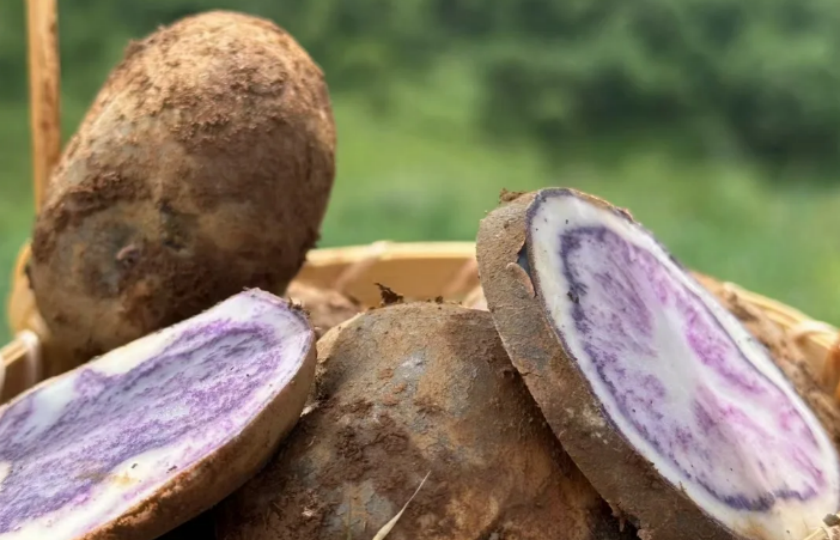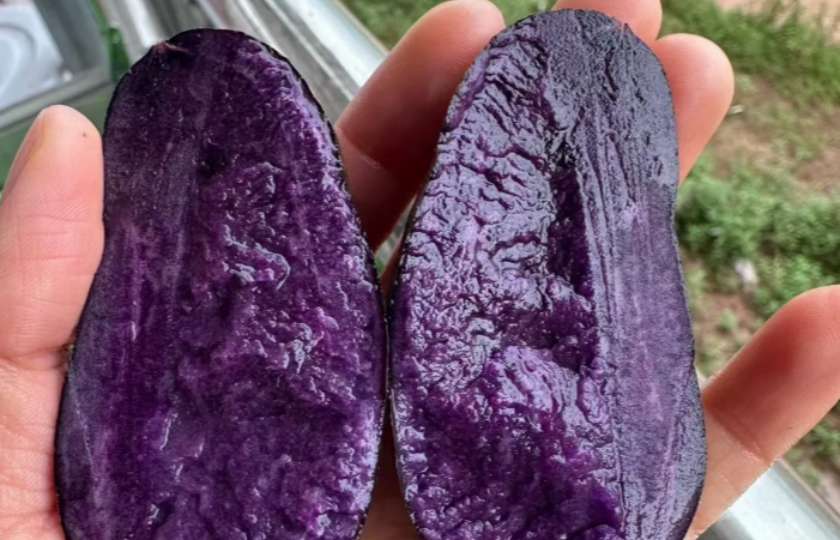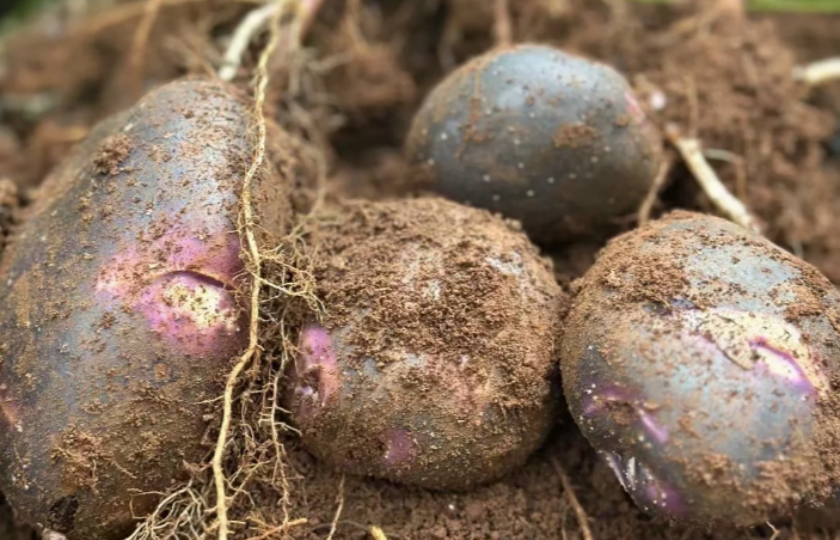Curious about the benefits of purple potatoes? Here's the nutritional value

Purple potatoes are very nutritious foods, but do you know what their nutritional value is? Today, let's talk about "What is the nutritional value of purple potatoes?" I hope it can be helpful to everyone.
What is the nutritional value of a purple potato?
The nutritional value of purple potatoes is mainly manifested in the following aspects:
Vitamins and minerals: Purple potatoes contain many nutrients such as vitamin C, B vitamins, vitamin A, calcium, iron, phosphorus, potassium, magnesium, zinc, etc. These substances are extremely crucial for maintaining the normal physiological functions of the human body.
Anthocyanins: Purple potatoes are rich in anthocyanins, which are a natural antioxidant with significant antioxidant effects. They can remove free radicals in the body, delay the aging process and protect the health of the cardiovascular system.
Dietary fiber: Purple potatoes contain a large amount of dietary fiber, which is beneficial to promoting intestinal peristalsis, preventing constipation and optimizing the intestinal environment.
Low calorie and high satiety: Purple potatoes are low in calories but have a strong sense of satiety. They are suitable for people who need to control their weight.
Enhance immunity: Purple potatoes are rich in vitamin C and zinc, which help strengthen immunity and prevent diseases such as colds.
Promote digestion: Purple potatoes are rich in dietary fiber and starch, which can promote the secretion of digestive juices, enhance the peristalsis of the gastrointestinal tract, and help the digestion and absorption of food.
Protect vision: Purple potatoes are rich in anthocyanins, which can protect the retina of the eyes, reduce the damage of free radicals to the eyes, and prevent the occurrence of eye diseases.
Beauty and beauty: The anthocyanins in purple potatoes have the effect of delaying aging. At the same time, their characteristics of low calorie and high dietary fiber are also beneficial for weight loss.
Nourish blood and stomach: Purple potatoes can promote the digestive function of the spleen and stomach. For people with weak spleen and stomach and indigestion, it is an ideal winter health food.
Do purple potatoes have more antioxidants than blueberries?
The antioxidant content of purple potatoes is higher than that of blueberries for the following reasons:
Antioxidant content
Purple potatoes: The anthocyanin content in every 1000 grams of purple potatoes is about 1700 milligrams. Anthocyanins are the most powerful free radical scavengers. The antioxidant effect is 20 times higher than that of VC.
Blueberries: The content of anthocyanin pigments in every 1000 grams of fresh blueberries is as high as 1630mg, which is slightly lower than that of purple potatoes.

Antioxidant capacity
Purple potatoes: The antioxidant capacity of anthocyanins is about fifty times higher than that of vitamin E and about twenty times higher than that of vitamin C.
Blueberries: The antioxidants rich in blueberries can fight free radicals and help prevent oxidative stress, thereby reducing the risk of chronic diseases.
It can be seen that purple potatoes are more prominent in terms of antioxidant content and antioxidant capacity, and are superior to blueberries in terms of antioxidant properties.
Can diabetics eat purple potatoes?
Diabetic patients can eat purple potatoes, but pay attention to the dosage.
Purple potatoes contain rich dietary fiber. This substance is helpful for controlling blood sugar and delaying the absorption of sugar powder. Compared with many high-sugar foods, purple potatoes are more suitable for diabetic patients.
But diabetic patients should also eat purple potatoes in moderation. At the same time, they should reduce the intake of other staple foods, such as rice and pasta, to avoid causing a rise in blood sugar.
Secondly, when diabetic patients eat purple potatoes, they should pay attention to the cooking method. Steaming and boiling purple potatoes are recommended. Fried ones are not suitable.
Do purple potatoes reduce inflammation?
Purple potatoes have a certain anti-inflammatory effect.
The anthocyanins rich in purple potatoes are a powerful antioxidant. They can not only remove free radicals in the body and slow down aging, but also have anti-inflammatory effects. Studies have shown that anthocyanins can effectively inhibit inflammatory reactions and reduce tissue damage caused by inflammation, and play a positive role in preventing and alleviating some chronic inflammatory diseases.

In addition, purple potatoes also contain some other beneficial phytochemicals, such as carotenoids and vitamin C. These ingredients also help reduce inflammation, strengthen the immune system and promote good health. The antioxidant and anti-inflammatory properties of purple potatoes are especially helpful in anti-aging, relieving arthritis, and reducing the inflammatory response of cardiovascular diseases.
However, although purple potatoes have anti-inflammatory potential, they cannot replace drug treatment. If you have health problems related to inflammation, it is recommended to consult a doctor and combine appropriate diet and treatment methods to help relieve symptoms.
What are purple potatoes best for?
There are many ways to eat purple potatoes. You can choose according to your own preferences. Here are several eating methods I recommend:
Baked purple potatoes
Cut purple potatoes into small pieces, place them on a baking tray, sprinkle with salt and black pepper, and bake for 20-30 minutes.
The baked purple potatoes are crispy on the outside and soft on the inside. They are very suitable as a staple food or snack.
Purple potato puree
Press the cooked purple potatoes into a puree, add an appropriate amount of milk or fresh cream, then add seasonings such as sugar, butter and salt, and stir well.
Purple potato puree has a rich and soft taste, suitable as a dessert or breakfast.
The difference between purple potatoes and ordinary potatoes
There are mainly the following differences:
Different colors
The skin of ordinary potatoes is usually yellow or brown, while the skin of purple potatoes is purple or dark purple. Because purple potatoes are rich in natural pigments such as anthocyanins and flavonoids, they form a unique color in their natural state.
Different nutritional components
Both purple potatoes and ordinary potatoes are starchy vegetables, but there are some differences in their nutritional components. Purple potatoes are rich in anthocyanins, antioxidants and various vitamins (especially vitamin C and vitamin A). These components are closely related to the prevention of diseases such as cancer, cardiovascular and cerebrovascular diseases and eye diseases. Ordinary potatoes are rich in substances such as vitamin B6, iron, potassium and carbohydrates.
There are differences in cooking methods
Due to the special color of purple potatoes, their cooking methods are relatively limited. Usually, it can be used as an ingredient in various potato salads, baked potatoes and mashed potatoes. In addition, purple potatoes can also be used to make purple potato cakes and purple potato chips and other dishes. In contrast, ordinary potatoes have a wider range of uses. They can be cooked in various ways such as baking, boiling, frying and stir-frying, and are suitable for various different dishes.
Different taste and texture
Purple potatoes and ordinary potatoes are also different in taste and texture. Due to the rich natural pigments and other nutritional components of purple potatoes, their taste is slightly softer than that of ordinary potatoes. The taste of ordinary potatoes is stronger and their texture is relatively tougher.























